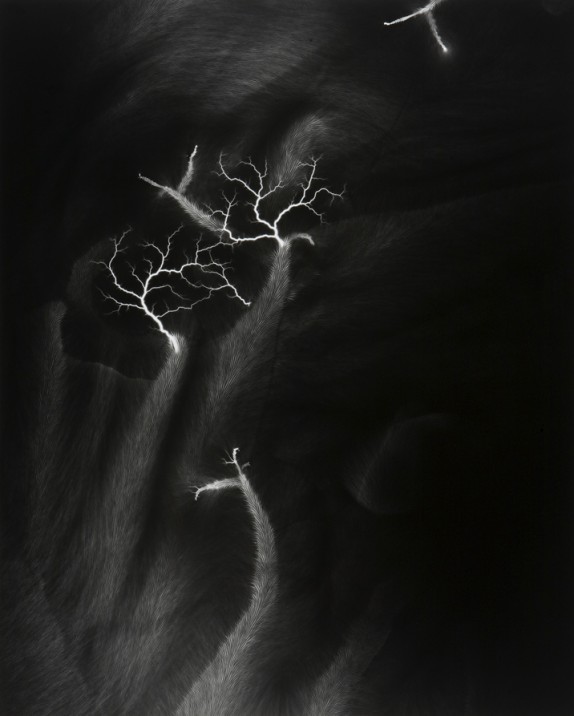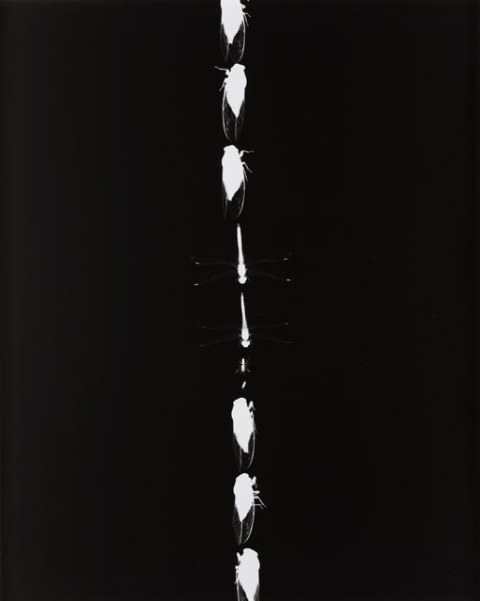 Ryuji Miyamoto has just had an exhibition of new work at Taro Nasu Gallery in Tokyo's equivalent of the meat-packing district, Higashi-kanda. These new photograms are quite a departure from his earlier work on the destruction of architecture. Miyamoto had already begun experimenting with photographic techniques for his previous series Pinhole, for which he built his own camera obscura. I have written about these pieces before, and now that I have seen more of the work I find the series to be even more strangely beguiling. They are beautiful, but invested with a sense of foreboding... images documenting the beginnings of a mass extinction. For those, like me, who missed the exhibition, Taro Nasu will be bringing some of these photograms to Paris Photo next month.
Ryuji Miyamoto has just had an exhibition of new work at Taro Nasu Gallery in Tokyo's equivalent of the meat-packing district, Higashi-kanda. These new photograms are quite a departure from his earlier work on the destruction of architecture. Miyamoto had already begun experimenting with photographic techniques for his previous series Pinhole, for which he built his own camera obscura. I have written about these pieces before, and now that I have seen more of the work I find the series to be even more strangely beguiling. They are beautiful, but invested with a sense of foreboding... images documenting the beginnings of a mass extinction. For those, like me, who missed the exhibition, Taro Nasu will be bringing some of these photograms to Paris Photo next month.
Mao Ishikawa
 At the Arles photo festival over the summer, I was introduced to Mao Ishikawa's work by Mark Pearson. Mao Ishikawa grew up on the islands of Okinawa, which meant a childhood where the US military was a major and unavoidable presence. Speaking about her relationship with the American military, she has said, “I have two hearts in one body,” describing her love for American soldiers and hatred of the American government. This love for the GIs led to Mao following them back to the United States in the 1980s. She ended up in Philadelphia living with soldier friends where she photographed their often difficult lives back at home. The images are raw and sometimes graphic, but there is a real tenderness and playfulness that comes through thanks to Ishikawa's close relationship to her subjects. This is a groundbreaking group of work from one of the first female Japanese photographers to break into the male-dominated world of photography.
At the Arles photo festival over the summer, I was introduced to Mao Ishikawa's work by Mark Pearson. Mao Ishikawa grew up on the islands of Okinawa, which meant a childhood where the US military was a major and unavoidable presence. Speaking about her relationship with the American military, she has said, “I have two hearts in one body,” describing her love for American soldiers and hatred of the American government. This love for the GIs led to Mao following them back to the United States in the 1980s. She ended up in Philadelphia living with soldier friends where she photographed their often difficult lives back at home. The images are raw and sometimes graphic, but there is a real tenderness and playfulness that comes through thanks to Ishikawa's close relationship to her subjects. This is a groundbreaking group of work from one of the first female Japanese photographers to break into the male-dominated world of photography.
Further reading: Biography (in Japanese)
Bishin Jumonji
 Bishin Jumonji has updated his website with work from his series Faces and some of his terrific headless portraits from the early 1970s which featured in MoMA's seminal New Japanese Photography show. When I met Jumonji in Kamakura earlier this year he showed me some examples of his latest work, but in black-and-white. These cubist portraits are shot on film with no digital post-processing whatsoever.
Bishin Jumonji has updated his website with work from his series Faces and some of his terrific headless portraits from the early 1970s which featured in MoMA's seminal New Japanese Photography show. When I met Jumonji in Kamakura earlier this year he showed me some examples of his latest work, but in black-and-white. These cubist portraits are shot on film with no digital post-processing whatsoever.
Review: Voyages @ MCJP
 I was contacted a few months ago by the Japan Foundation in Paris to write a short text for their newsletter based on an upcoming exhibition of contemporary Japanese photography. The exhibition, put together by the Tokyo Metropolitan Museum of Photography, has just opened and although I'm not entirely convinced about the theme, voyages, there is some interesting and fresh material here, most of which has probably never been shown in Europe before.
I was contacted a few months ago by the Japan Foundation in Paris to write a short text for their newsletter based on an upcoming exhibition of contemporary Japanese photography. The exhibition, put together by the Tokyo Metropolitan Museum of Photography, has just opened and although I'm not entirely convinced about the theme, voyages, there is some interesting and fresh material here, most of which has probably never been shown in Europe before.
Naoki Ishikawa and Koji Onaka were the only two photographers in the exhibition whose work I already knew. Ishikawa is pretty popular in Japan and his books Polar, New Dimension and Mount Fuji seemed to have pride of place in most bookstores on my last few trips to Tokyo. I had the chance to speak with him briefly at the opening of the exhibition and he explained that he is particularly interested in trying to find a new way of photographing 'icons' like Mount Fuji. When I first came across his work on Fuji-san, it made me realise that I had almost never seen images of the mountain that were taken up close. It is almost always photographed or portrayed at a respectful distance (try doing a Mount Fuji Google Images search), reinforcing its symbolic nature to the point where you have to wonder whether the real mountain actually exists. Ishikawa takes a very different approach, showing the mountain up close, and revealing it as a barren, sometimes dangerous and desolate place.
Koji Onaka was the highlight of the exhibition for me. I have posted about his work before, but this is the first time I have seen his prints. Onaka began shooting in black and white but has since moved on to colour with very interesting results. He was one of Daido Moriyama's students and he shares Moriyama's obsession with dogs. Onaka is more of a wanderer than a traveller and his subject is the old, slightly run-down pockets of the rapidly disappearing 'old' Japan. His colours match these locations, as if they have turned slightly with age. He makes his prints himself in very small formats, and the results are wonderful.
Takeshi Dodo also deserves a mention for his black and white work on the islands of Okinawa. There are a number of images that reminded me of Kazuo Kitai, Issei Suda or Hiromi Tsuchida, in their very 'real', straightforward and unaffected vision of daily life. Dodo is not overly prone to nostalgia and the modern aspects of life on these remote islands rub right up against the more traditional to create an intriguing portrait of a world that is both far removed from and closely connected to the incessant modernisation of the country.
I will put a link to my text (in French) once they upload the newsletter to the MCJP website.
Rating: Recommended
Voyages, Maison de la culture du Japon 14 October 2009 - 23 January 2010
Hiroshi Sugimoto: Lightning fields
 Hiroshi Sugimoto is showing prints from his latest series in progress, Lightning Fields, at the Fraenkel Gallery in San Francisco. Each image is created by applying an electrical charge from a 400,000-volt Van De Graaff generator directly onto the negative. I find them truly stunning.
Hiroshi Sugimoto is showing prints from his latest series in progress, Lightning Fields, at the Fraenkel Gallery in San Francisco. Each image is created by applying an electrical charge from a 400,000-volt Van De Graaff generator directly onto the negative. I find them truly stunning.


